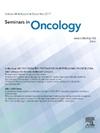Baicalein and baicalin in cancer therapy: Multifaceted mechanisms, preclinical evidence, and translational challenges
IF 2.5
3区 医学
Q2 ONCOLOGY
引用次数: 0
Abstract
Natural compounds with multitargeted actions are gaining prominence in oncology for their potential to complement and transcend the limitations of conventional therapies. Among them, baicalein and baicalin, two flavonoids primarily isolated from Scutellaria baicalensis, have attracted attention for their broad-spectrum anticancer properties. This review synthesizes current evidence from cellular systems, animal models, and early-phase clinical studies, exploring their pharmacological potential and translational relevance. Both molecules interfere with key hallmarks of cancer, including proliferation, survival, angiogenesis, metastasis, and immune evasion. Mechanistically, they modulate interconnected signaling cascades governing apoptosis, inflammation, and cell cycle control, and they enhance tumor sensitivity to chemotherapy and radiotherapy. In-vivo models consistently demonstrate tumor growth inhibition, while clinical data suggest a favorable safety profile, even at relatively high oral doses. However, their clinical translation remains hampered by limited solubility, poor oral bioavailability, and rapid metabolism, factors that continue to constrain their therapeutic window. Efforts to overcome these barriers through structural modification, encapsulation strategies, and advanced delivery systems are underway, yet few have advanced beyond preclinical validation. Despite these pharmacokinetic limitations, baicalein and baicalin remain compelling candidates for integrative oncological approaches. Their pleiotropic mechanisms, combined with low toxicity and synergistic behavior with standard therapies, position them as prototypes for a new generation of phytochemical-based anticancer agents. Continued work is needed to resolve formulation challenges and define precise molecular targets, but their trajectory reflects the growing scientific and clinical momentum around rationally designed natural compound therapeutics.
黄芩素和黄芩苷在癌症治疗中的作用:多方面的机制、临床前证据和转化挑战
具有多靶点作用的天然化合物在肿瘤学中越来越突出,因为它们具有补充和超越传统治疗局限性的潜力。其中黄芩苷(baicalein)和黄芩苷(baicalin)是主要从黄芩中分离得到的两种黄酮类化合物,因其广谱抗癌特性而备受关注。这篇综述综合了目前来自细胞系统、动物模型和早期临床研究的证据,探索了它们的药理潜力和翻译相关性。这两种分子都会干扰癌症的关键特征,包括增殖、存活、血管生成、转移和免疫逃逸。在机制上,它们调节相互关联的信号级联,控制细胞凋亡、炎症和细胞周期控制,并增强肿瘤对化疗和放疗的敏感性。体内模型一致显示肿瘤生长抑制,而临床数据显示良好的安全性,即使在相对较高的口服剂量。然而,它们的临床转化仍然受到溶解度有限、口服生物利用度差和快速代谢等因素的阻碍,这些因素继续限制它们的治疗窗口期。通过结构修改、封装策略和先进的给药系统来克服这些障碍的努力正在进行中,但很少有超过临床前验证的进展。尽管存在这些药代动力学的局限性,黄芩苷和黄芩苷仍然是综合肿瘤学方法的有力候选者。它们的多效性机制,加上低毒性和与标准疗法的协同作用,使它们成为新一代基于植物化学的抗癌药物的原型。需要继续开展工作来解决配方挑战和确定精确的分子靶点,但它们的发展轨迹反映了围绕合理设计天然化合物疗法的科学和临床势头的增长。
本文章由计算机程序翻译,如有差异,请以英文原文为准。
求助全文
约1分钟内获得全文
求助全文
来源期刊

Seminars in oncology
医学-肿瘤学
CiteScore
6.60
自引率
0.00%
发文量
58
审稿时长
104 days
期刊介绍:
Seminars in Oncology brings you current, authoritative, and practical reviews of developments in the etiology, diagnosis and management of cancer. Each issue examines topics of clinical importance, with an emphasis on providing both the basic knowledge needed to better understand a topic as well as evidence-based opinions from leaders in the field. Seminars in Oncology also seeks to be a venue for sharing a diversity of opinions including those that might be considered "outside the box". We welcome a healthy and respectful exchange of opinions and urge you to approach us with your insights as well as suggestions of topics that you deem worthy of coverage. By helping the reader understand the basic biology and the therapy of cancer as they learn the nuances from experts, all in a journal that encourages the exchange of ideas we aim to help move the treatment of cancer forward.
 求助内容:
求助内容: 应助结果提醒方式:
应助结果提醒方式:


